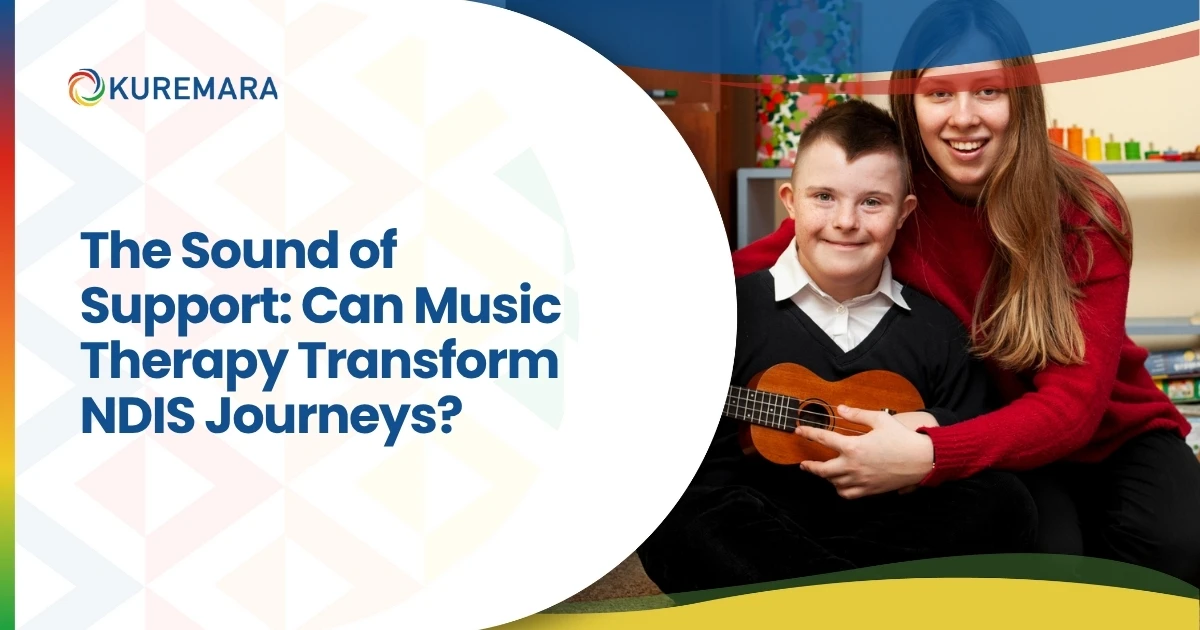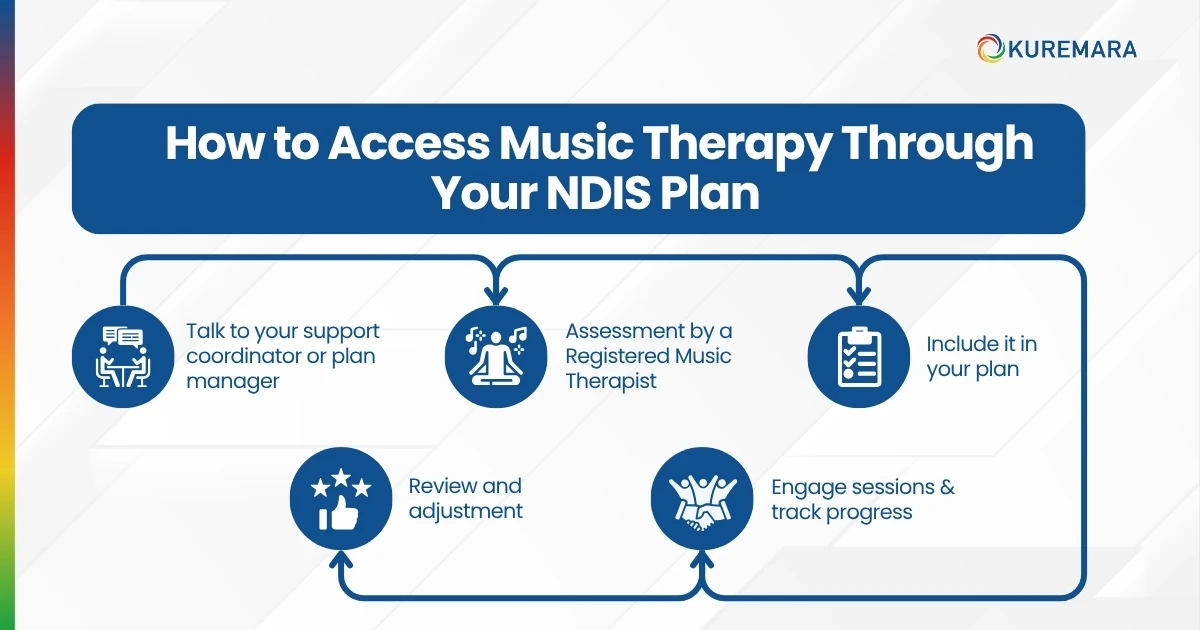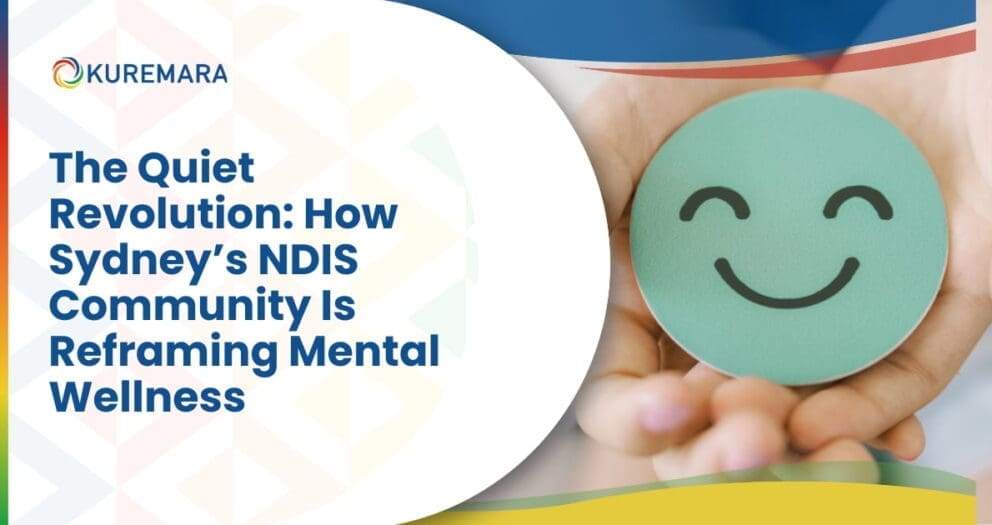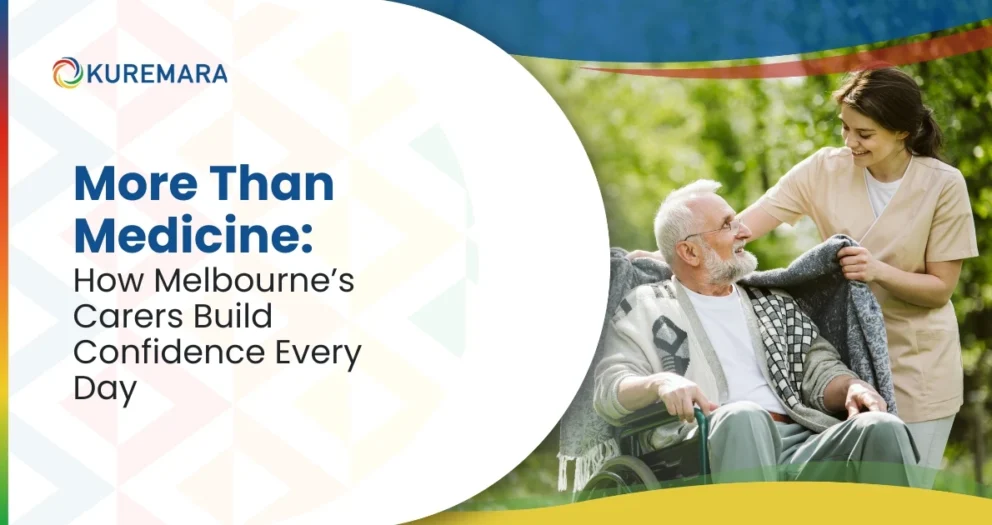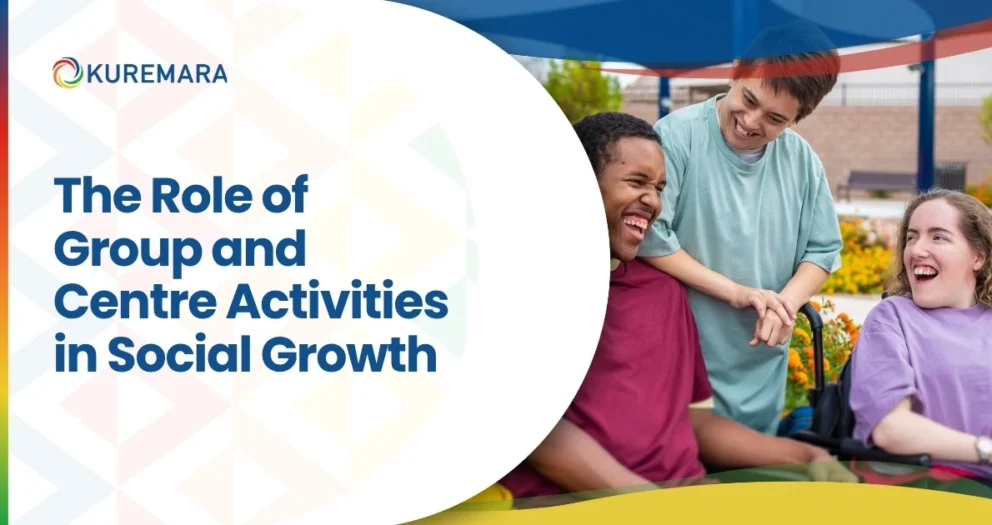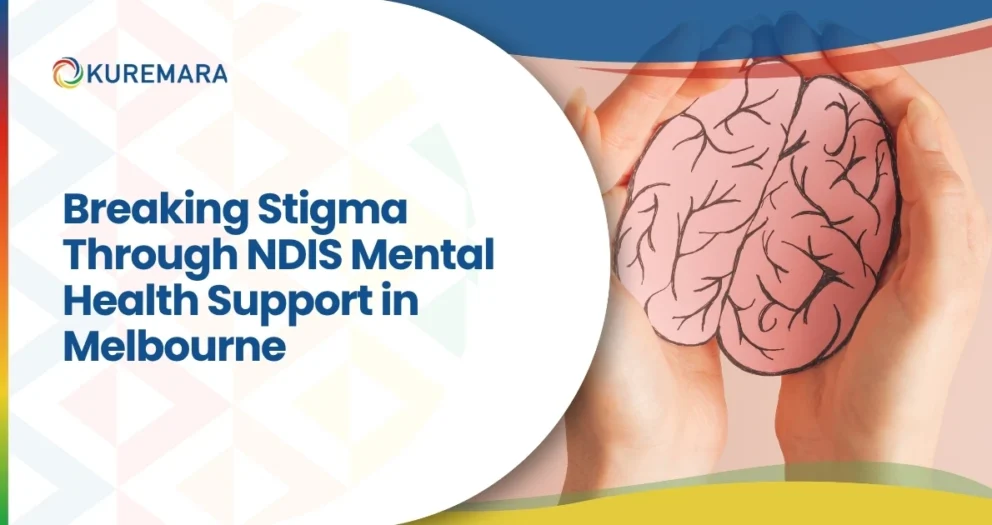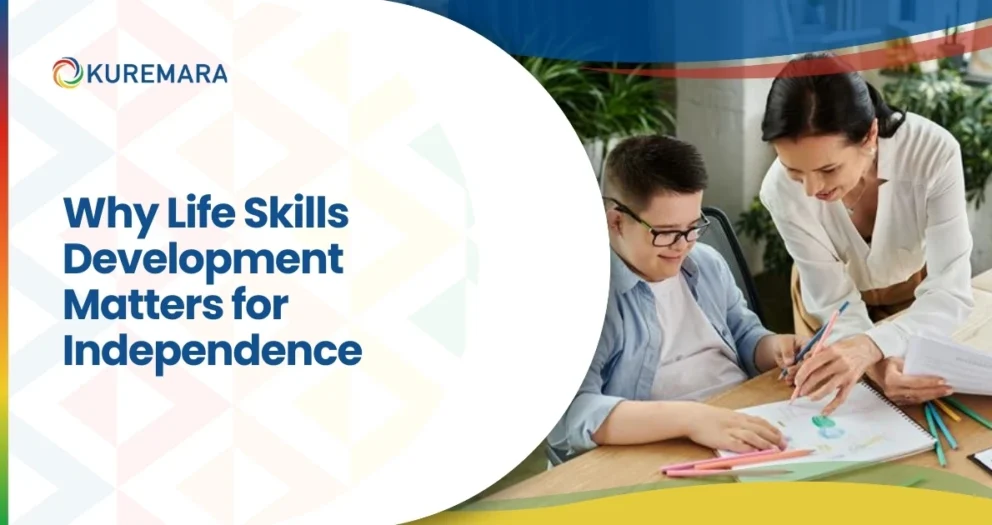When words fall short, melodies often speak. For many individuals living with disabilities, traditional communication or emotional expression may present challenges, but music taps into the deeper parts of us, transcending barriers of speech, memory, and mood. At Kuremara, we believe that support comes in many forms, and sometimes, the most powerful tool is a simple rhythm, a familiar tune, or a shared beat.
But beyond the poetic appeal, can music therapy really transform NDIS journeys in ways that are meaningful, measurable, and lasting? In this article, we explore what music therapy is, how it fits into the NDIS framework, its evidence base, and how Kuremara can help participants access this form of support in their plans.
What Is Music Therapy?
Music therapy is a clinical and evidence-based use of musical interventions such as singing, instrument playing, rhythm, songwriting, and guided listening to support a person’s emotional, cognitive, social, physical, and sensory goals. It is not simply “music for fun”; rather, it is a structured therapeutic approach delivered by trained and registered music therapists.
Unlike casual engagement with music, music therapy is goal-directed and tailored: therapists assess, plan, monitor progress, and reset goals in coordination with the participant, their family, and allied health professionals.
By design, it is inclusive. Sessions can be adapted to abilities, preferences, cultural contexts, and sensory needs, making it a versatile tool across age groups and conditions.
Music Therapy & the NDIS: Building Bridges of Support
Eligibility and Plan Integration
Under the NDIS, music therapy is recognised as a funded allied health support, specifically under the Capacity Building – Improved Daily Living category. Registered music therapists (those accredited with the Australian Music Therapy Association, AMTA) can provide sessions that contribute directly toward NDIS goals.
Importantly, only registered music therapists qualify under the NDIS for claiming music therapy as therapy support; community musicians or educators, though valuable, do not meet the same funding criteria. Refer to NDIS Funded Music & Art Support for details.
Kuremara, as an NDIS-registered organisation, can assist participants in nominating music therapy in their plans, coordinating with therapists, and documenting evidence to align with plan reviews.
Recent Changes & Pricing Review (2024–25)
Music and art therapies recently underwent scrutiny in the NDIS review process. The Duckett Review affirmed that art and music therapies can continue to be funded when supported by evidence and delivered by qualified practitioners. As a result, a new national price cap of AUD 156.16 per hour for art and music therapy was set to take effect from November 24, 2025. (Source: NDIS)
Prior to that, debate emerged about earlier caps (e.g. AUD 67.56/hour for one-to-one sessions. Source: NDIS ) and access constraints unless functional improvements could be demonstrated. In light of these changes, it is more important than ever for participants and providers to clearly articulate therapy goals, track outcomes, and integrate documentation in reviews.
The Science of Sound: Why Music Heals
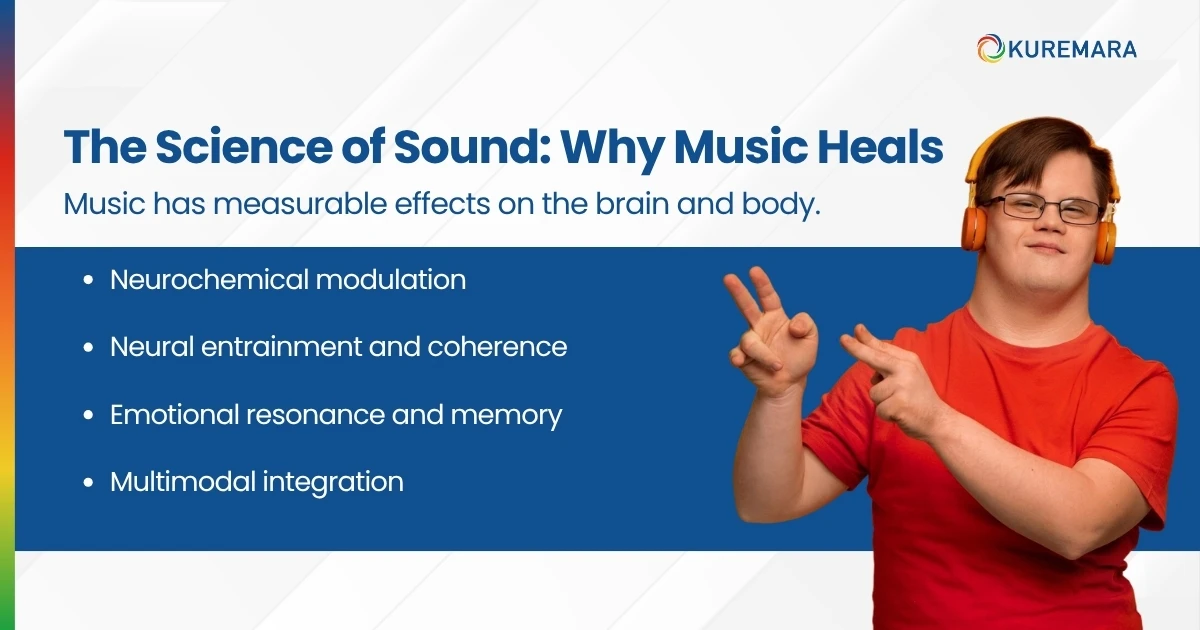
Music is not simply aesthetic; it has measurable effects on the brain and body. Some of the mechanisms by which music therapy exerts benefit include:
- Neurochemical modulation: Music listening and participation can trigger release of dopamine and endorphins and reduce cortisol, thus lowering stress and enhancing mood.
- Neural entrainment and coherence: Rhythmic structures in music can help regulate neural synchronisation and timing, supporting attention and executive processing.
- Emotional resonance and memory: Music taps into emotional and autobiographical memory networks, making it a potent tool for people with dementia or trauma.
- For instance, person-centered music (familiar tunes) has been shown to reduce behavioural disturbances in dementia. (Source: MDPI)
- Multimodal integration: In many sessions, music is paired with movement, speech, or sensory exercises. This cross-modal stimulation enhances motor coordination, language pathways, and sensory regulation.
The evidence base is steadily growing meta-analyses, and reviews show positive effects in areas such as mood regulation, social interaction, motor skills, cognition, and communication. While high-quality randomized controlled trials are still limited in scope, outcomes from real-world clinical practice reflect meaningful changes. (Source: PMC)
Transformative Benefits of Music Therapy for NDIS Participants
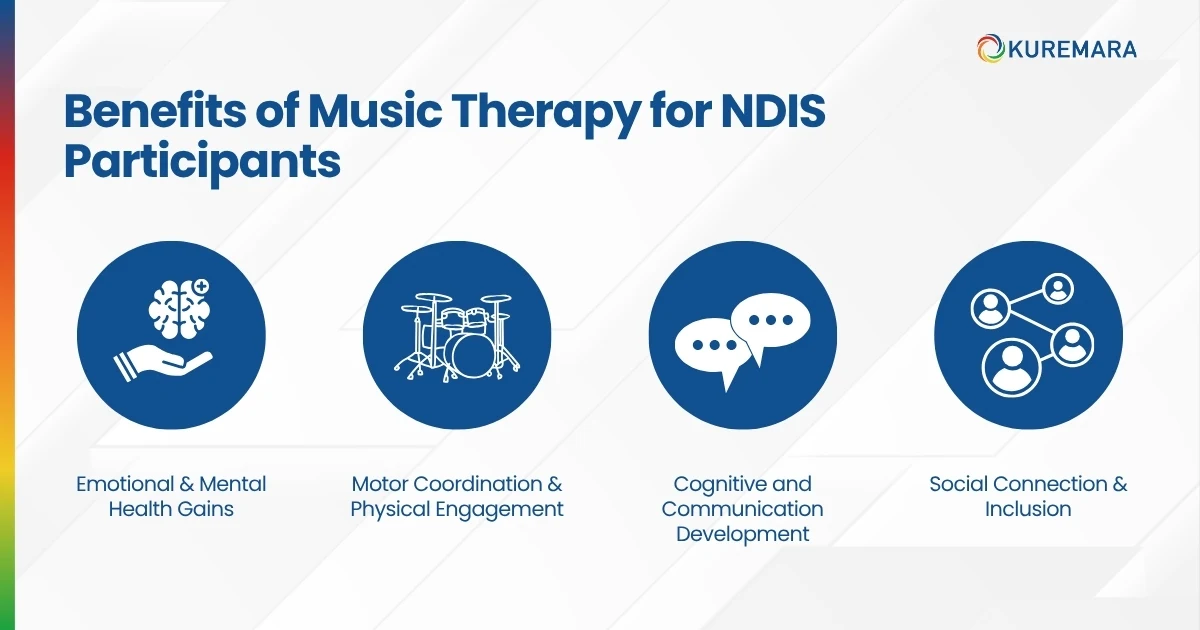
Here’s how music therapy tangibly supports people with disability in their NDIS journey:
1. Emotional & Mental Health Gains
- Reduces anxiety, depression, and emotional dysregulation through expressive sound and structured sessions.
- Provides a non-verbal outlet when spoken language is limited.
- Facilitates emotional resilience and self-esteem, particularly when participants co-create music or improvise.
2. Motor Coordination & Physical Engagement
- Instrumental playing and rhythmic movement (drumming, tapping, clapping) promote fine and gross motor control.
- Music-driven motion can support gait training, upper-limb coordination, and bilateral integration in rehabilitation settings.
3. Cognitive & Communication Development
- Stimulates memory, attention, executive function, and language processing.
- Supports speech development, especially when combined with lyrics or vocalisation.
- For autism (ASD), improving joint attention, turn-taking, and symbolic expression has been documented. (Source: PMC)
4. Social Connection & Inclusion
- Group sessions foster collaboration, belonging, and reciprocal engagement.
- Shared musical experiences can strengthen relationships between participants, carers, and family.
- Encourage participation in community music or ensemble settings.
Together, these benefits show how music therapy can be an integrative support across domains- emotional, physical, cognitive, and social.
Music Therapy & Specific Conditions
a. Music Therapy and Autism (ASD)
Autistic participants often experience challenges with sensory regulation, social communication, and expressive language. Music therapy offers:
- Structured predictability through rhythm and repetition.
- Nonverbal communication pathways (melody, gesture) for expression beyond spoken words.
- Improvements in social, emotional, and behavioural domains; many studies show positive gains in these areas. (Source: PMC)
- Even though rigorous RCTs remain limited, the pattern of effect is strong in observational and quasi-experimental studies. PMC
An especially promising direction is multisensory collaborative music-art paradigms (like the “MusicTraces” model) co-designed with participants to maintain engagement and co-creation.
b. Music Therapy and Dementia
People living with dementia often face memory loss, emotional distress, and behavioural and psychological symptoms (BPSD). Music therapy can:
- Trigger autobiographical memory, mood recall, and connection to identity.
- Reduce agitation, improve mood, and ease distress when delivered in person-centered formats. (Source: Frontiers)
- Serve across all stages of dementia through passive listening or active singing, adapting to cognitive capacity. (Source: Frontiers)
- Be embedded in care settings (e.g., hospital wards) to complement multidisciplinary support.
- Leverage technological supports (apps, adaptive music playback) to extend music access in home settings. (Source: arXiv)
As global dementia prevalence rises (55 million+ worldwide as of recent estimates), non-pharmacological interventions like music therapy grow increasingly important. (Source: Frontiers)
c. Other Neurodivergent/Acquired Conditions
Music therapy also offers benefits in areas like:
- Mental health (depression, anxiety, and trauma) via emotional regulation.
- Neurological recovery (e.g., stroke, acquired brain injury) through rhythm-based motor rehabilitation.
- Sensory processing and executive control in conditions like ADHD or acquired cognitive impairment. (Source: ScienceDirect)
The capacity of music to multiply across domains makes it ideal for participants with complex or intersectional needs.
A Day in a Music Therapy Session
Here’s a walkthrough of a typical session emphasising inclusive, person-centered delivery:
1. Welcome & check-in
- The therapist encourages participants to share mood or intention (verbally, via gesture, or by selecting a “feeling” sound).
- The space is sensory-aware (e.g., adjustable lighting, instrument accessibility).
2. Warm-up/grounding
- Gentle breathing with sound or simple rhythmic clapping.
- Listening to participant-preferred music (to orient and validate).
3. Active engagement/creation
- Instrument play, vocal improvisation, songwriting, call-and-response.
- Rhythm movement or body percussion if physical capacity allows.
4. Guided listening/reflection
- Listening to curated music (often participants’ preferences).
- Reflecting through discussion, drawing, movement, or gesture.
5. Closing & wrap-up
- Creating a short “sound ritual” to mark the session end.
- Therapists and participants reflect on what was meaningful, set goals for next time.
Each session is adapted for pace, sensory needs, preferred musical genres, and the cognitive/physical capacity of the participants. For participants with limited verbal capacity, nonverbal methods (gesture, drawing, music selection) guide engagement.
How to Access Music Therapy Through Your NDIS Plan
Step 1: Talk to your support coordinator or plan manager
Discuss whether music therapy aligns with your goals, for example, emotional regulation, communication, motor skills, or social inclusion.
Step 2: Assessment by a Registered Music Therapist
A qualified therapist conducts a baseline assessment, formalises goals, and proposes a session plan.
Step 3: Include it in your plan
Ensure music therapy is listed under Capacity Building Improved Daily Living. Provide assessment reports, therapist credentials, and justification based on functional outcomes.
Step 4: Engage sessions & track progress
Carry out regular therapy, document outcomes, and collect participant/therapist progress notes.
Step 5: Review and adjustment
At your plan review, present progress evidence, outcome data, narratives, video/audio recordings, to support continuation or adjustment of funding.
Kuremara can assist every step: from connecting you with registered music therapists nationwide, helping with plan submissions, documenting outcomes, and coordinating therapy within your broader support ecosystem.
Kuremara’s Approach: Harmonising Support & Creativity
At Kuremara, we believe in holistic, person-centered support. Music therapy sits alongside art therapy, sensory-based programs, and capacity-building services to create multi-modal pathways toward greater wellbeing.
- We partner with AMTA-registered music therapists to deliver safe, evidence-aligned sessions.
- Our supports integrate seamlessly with SIL (Supported Independent Living), Community Access, and psychosocial services.
- We emphasise choice, cultural relevance, and inclusive design: participants co-design their musical journey, selecting genres, instruments, and pacing.
- We provide documentation support, outcome reporting, and advocacy, helping participants retain access to creative therapies even through funding changes.
Future of Music Therapy in NDIS Support
The upcoming years hold cautious optimism and change:
- With the Duckett Review, music and art therapies are reaffirmed within NDIS, contingent on quality evidence and registered providers.
- The new price cap of AUD 156.16/hour offers clarity on funding expectations.
- The NDIS Evidence Advisory Committee is expected to further assess and expand evidence bases into 2025–26.
- Research trends continue expanding, especially in standardised protocols, digital delivery, and culturally responsive models.
- Innovations like mobile apps, music cognition tools, and tech-assisted music therapy platforms are emerging as hybrid supports.
These developments suggest that the role of music therapy in disability support will grow, but maintaining access will depend on strong documentation, aligned goals, and participant-led design.
Conclusion: Let the Rhythm Guide Recovery
Music holds a soft power: a melody that touches memory, a rhythm that steadies a heartbeat, and a shared beat that bridges connection. For many NDIS participants, music therapy is not just support, it becomes a language of healing, inclusion, and agency.
Through emotional expression, motor engagement, social connection, and cognitive stimulation, music therapy can reshape NDIS journeys, especially when integrated with robust planning, tracking, and advocacy.
At Kuremara, we invite you to explore this creative path. Our commitment is to walk with you, help you petition for inclusive supports, and co-create a journey where every beat counts toward greater independence, dignity, and joy.
 care@kuremara.com.au
care@kuremara.com.au
